Cumaná
Cumaná (Spanish pronunciation: [kumaˈna]) is the capital City of Venezuela's Sucre State. It is located 402 kilometres (250 mi) east of Caracas. Cumaná was one of the first cities founded by Europeans in mainland America and is the oldest continuously-inhabited European-established city in the continent. Its early history includes several successful counters by the indigenous people of the area who were attempting to prevent Spanish incursion into their land, resulting in the city being refounded several times. The municipality of Sucre, which includes the capital city, Cumaná, had a population of 358,919 at the 2011 Census; the latest estimate (as at mid 2016) is 423,546.[1]
Cumaná | |
|---|---|
City | |
.jpg) 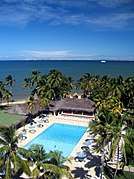  | |
 Flag  Seal | |
| Motto(s): La tierra donde nace el sol, Primogénita del continente americano (English):"The land where the sun rises, Firstborn of the American Continent") | |
.svg.png) Cumaná | |
| Coordinates: 10°27′23″N 64°10′3″W | |
| Country | |
| State | Sucre |
| Municipality | Sucre |
| Founded | 1515 |
| Government | |
| • Type | Mayor–council |
| • Mayor | Rafael Acuña |
| Area | |
| • Total | 598 km2 (231 sq mi) |
| Elevation | 43 m (141 ft) |
| Population (2016) | |
| • Total | 423,546 |
| • Demonym | Cumanés |
| Demonym(s) | cumanés (m), cumanesa (f) |
| Time zone | VST |
| Postal code | 6101 |
| Area code(s) | 0293 |
| Climate | BSh |
| Website | www.alcaldiabolivarianadesucre.com(in Spanish) |
The city is located at the mouth of the Manzanares River on the Caribbean coast, in the northeast of Venezuela. It is home to first and most important of the five campuses of the Universidad de Oriente, and is a busy maritime port, home of one of the largest tuna fleets in Venezuela. The city is close to Mochima National Park, whose beaches are a popular tourist destination among Venezuelans.
Key heroes of and contributors to the Venezuelan independence movement were born in Cumaná, including Antonio José de Sucre, the ‘Gran Mariscal de Ayacucho,’ a leading general and President of Bolivia; as well as Brigadier General D. Juan Francisco Echeto. Cumaná is also the birthplace to eminent poets, writers and politicians like Andrés Eloy Blanco, an important figure in Latin American literature and who later rose to the national political scene; as well as José Antonio Ramos Sucre, another distinguished poet and diplomat. Several important scientists including Pehr Löfling from Sweden, Alexander von Humboldt from Germany, and Aimé Bonpland from France accomplished experimental works and discoveries while visiting or living in Cumaná in the 18th century. The city is also home to a Toyota plant, which manufactures the Hilux and Toyota Fortuner.
History
Cumaná was the first settlement founded by Europeans in Venezuela, established in 1515 by Franciscan friars,[2] under the name Nueva Toledo, but due to successful attacks by the indigenous people (such as the Cumanagoto people), it had to be refounded several times until Diego Hernández de Serpa's refoundation in 1569 with the name of Cumaná. Bartolomé de las Casas, attempting a peaceful colonization scheme, was pre-empted by Gonzalo de Ocampo's 1521 punitive raids against the local indigenous people, in retaliation for the destruction of the Dominican convent at Chiribichi. In 1537 New Andalusia Province was established, with Cumaná as capital (for which the Province was also known as the Province of Cumaná).
After Amerindian attacks became less of a threat, the city was on several occasions destroyed by earthquakes. Thus the oldest part of the city is late 17th and 18th century; almost none of the 16th century architecture survived.
Attractions
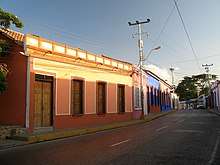
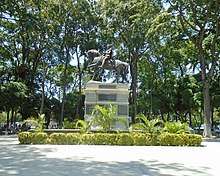
The city features a wide variety of colonial style architecture still in excellent condition. The San Antonio de la Eminencia Castle, a large Spanish fort, is open to the public and can be seen from the beach. Also surviving is the Santa Maria de la Cabeza castle, which was built in 1669. The Museo del Mar (Museum of the Sea) displays marine and maritime artifacts.
Indigenous species
The Cumana region is home to the Endler's livebearer, a spectacular, vibrantly coloured aquarium fish named after John Endler who discovered it in a lake in the area, Laguna de Los Patos. This fish is now extinct within the lake but thrives in home aquaria across the world with breeders producing spectacular fish.
Notable people from Cumaná
- Iñaki Anasagasti (b. 1947), Spanish politician, member of the Basque Nationalist Party (PNV)
- Rafael Betancourt (b. 1975), relief pitcher for Colorado Rockies
- Andrés Eloy Blanco (1897–1955), poet, humorist and politician
- Antonio José de Sucre (1795–1830), South American independence leader
- Armando Galarraga (b. 1982), starting pitcher for Detroit Tigers
- César Jiménez (b. 1984), left-handed relief pitcher for Seattle Mariners
- Luis Maza (b. 1980), shortstop for Los Angeles Dodgers
- Vanessa Peretti (b. 1986), first deaf entrant in the Miss Venezuela pageant
- Francisco Sánchez (b. 1976), butterfly and freestyle swimmer
- Jesús Sucre (b. 1988), catcher for Seattle Mariners
- José Antonio Ramos Sucre (1890–1930), poet and diplomat
- Juan Alvaro Lopez, filmmaker
- Jackle “Jacky” Mata (b. 2001), International Model, artist and actress
Views
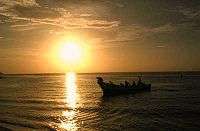 A peñero, or traditional fisherman's boat, at Mochima National Park
A peñero, or traditional fisherman's boat, at Mochima National Park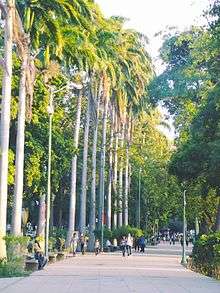 Ayacucho Park in Cumaná
Ayacucho Park in Cumaná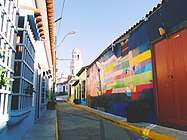 Historical quarter of Cumaná
Historical quarter of Cumaná San Luis Beach
San Luis Beach
References
- Instituto Nacional de Estadistica, Caracas.
- Floyd, Troy (1973). The Columbus Dynasty in the Caribbean, 1492-1526. Albuquerque: University of New Mexico Press. pp. 204–210.
- Krzysztof Dydniski & Charlotte Beech, Lonely Planet Venezuela, (2004)
External links
